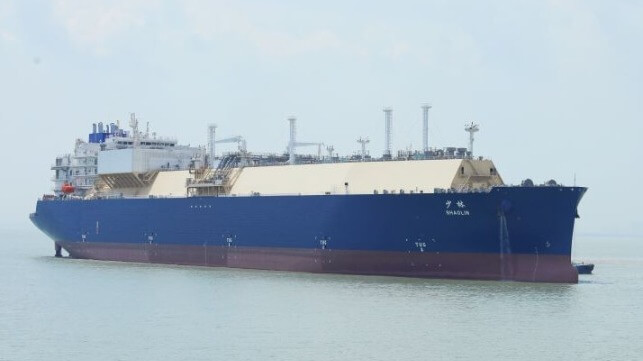China Builds Position in LNG Carrier Construction Market

Chinese shipbuilders are continuing to make inroads into the market for large LNG carriers as the vessels remain in strong demand and the building slots at South Korea’s three main yards are in short supply. The privately-owned Yangzijiang Shipbuilding company reports that it has received its first-ever order for large LNG carriers making it the first private shipyard in China to receive such an order and only the fourth domestic shipbuilder to have orders for large gas carriers. News of the order comes just after China State Shipbuilding announced that it had letters of intent for $1 billion in new LNG carriers and began the delivery of previously ordered gas carriers.
Newbuilding orders for LNG carriers have been leading the industry in 2022 as shipping companies rush to meet demand in the wake of the European efforts to replace Russian gas supplies which had been mostly transported by pipeline. In addition, Qatar is supporting the shipping industry’s expansion as it prepares to open a major expansion of its LNG production.
At mid-year, orders for large LNG carriers (exceeding 140,000 cbm) were the highest in 22 years according to Clarksons. The UK-based research company reported that orders were up by at least a quarter in 2022 with the global orderbook standing at 255 gas carriers, which represents a 40 increase in capacity. Orders in 2022, as of mid-year, had already surpassed 100 LNG carriers versus 86 orders in all of 2021.
Yangzijiang, which builds bulkers, containerships, and tankers, has been targeting the LNG carrier market announcing in September that it had signed an agreement with France’s GTT (Gaztransport & Technigaz). The shipbuilder is licensing GTT’s containment technology.
“The group's development has entered a new journey and opened a new chapter,” said Ren Letian, Executive Chairman and Chief Executive Officer of Yangzijiang. “The large-scale LNG carrier market has traditionally been Led by South Korean shipyards, but Yangzijiang Shipbuilding has successfully made a breakthrough and has become the first private shipbuilding enterprise in China to enter this field.”
The new order is for two standard-sized large LNG carriers to be built for unnamed European shipowners. The two 175,000 cbm carriers are scheduled for delivery in 2025 and 2026. They will use GTT’s containment technology along with MAN dual-fuel engines.
Yangzijiang is calling the orders a “foothold in this section,” citing the strong growth expected in the LNG market. Before these latest orders, the shipyard had already reached an all-time high for its orderbook in 2022. The company recently reported it had orders valued at more than $10 billion. No value was announced for the LNG carrier orders which typically are above $225 million each.
The state-owned CSSC group announced earlier this week that its Jiangnan Shipbuilding group had signed letters of intent to construct six new LNG carriers valued at approximately $1 billion. This includes orders for 175,000 cbm large LNG carriers as well as four 98,000 cbm very large ethane carriers (VLECs).

that matters most
Get the latest maritime news delivered to your inbox daily.
CSSC’s Hudong-Zhonghua Shipbuilding also marked the completion of the first large gas carrier it is building for COSCO and China National Petroleum Corporation (CNPC). The shipyard highlighted that the vessel which is 968 feet long with a capacity of 174,000 cbm was independently designed. It was optimized to the planned route and uses dual-fuel low speed propulsion to achieve fuel consumption of under 100 tons per day while operating at 19.5 knots. The shipyard has orders for a total of six LNG carriers for the COSCO partnership.
The Chinese shipbuilding industry is quickly building its international orderbook for gas carriers seeking to expand market share. This comes as South Korea continues to dominate the sector but its yards are struggling with rising costs and labor issues. The South Korean government has committed to increasing its investment in new technologies and labor to help its shipyards to remain competitive and develop new technologies for future high-value ships.
